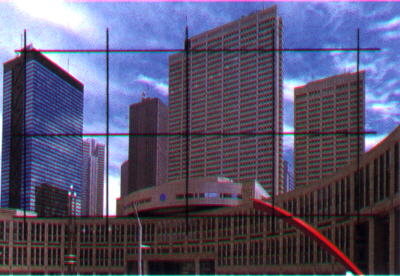|
Click to recommend this page:
| |
Picture taken with a 50mm lens
on a normal 35mm Camera

|
When a camera's lens captures light and reflects it, the light bends in
appropriate ways, depending on the angle of the viewer. This is similar to
how your eyes work: when you tilt your head up, your eye sees things
differently than if you look straight ahead, although you may not notice
it because your brain has learned to accommodate for the perspective change.
The two photos below demonstrate this principal: the first photo illustrates
how your eye may see the buildings if you tilt your head up. The second
photo shows what the buildings would look like if you kept your head level,
looking straight ahead. The whole idea behind perspective control lenses is
to simulate this effect.
This first picture was taken with a normal 35mm camera using a
conventional 50mm lens. The buildings are slanted and bent due to lens
having to point up to capture them on film. This "convergence" is due to
the shape of the lens and what it does to light when placed at certain
angles with respect to the film plane.
Same picture taken with a 50mm lens
with Perspective Control

|
This second picture was taken with the same camera standing in the
same spot using a perspective control lens. That is, the lens can
move independently of the camera body. Here, instead of tilting the entire
camera upwards to catch the entire view of the buildings, the camera
remains level so that the film plane is parallel to the buildings. To get
them into view, the lens is moved up without tilting upwards. That is,
it "rises", but remains parallel to the film plane, which remains parallel
with the fronts of the buildings (which are assumed to be perpendicular to
the ground). This shifts more of the top part of the cone of vision
created by the lens onto the film.
The center of the view is not in the center of the image, but closer to
the bottom of the image, where your eye would be if you were looking
straight ahead.
While the difference is subtle, the effect is dramatic. The superimposed
grid demonstrates how you can keep horizontal and vertical lines straight.
Footnotes about PC lenses
Perspective Control (PC) lenses can move up or down ("rise" or "fall") in the
manner described so they can adjust the view of the scene to give greater
control over what actually hits the film without the effects of distortion.
In addition to the up and down movements, they also have tilt
capabilities, which allow the lens or the film back to tilt at angles, in
all directions. Tilting the angle of the lens with respect to the film
plane adjusts the plane of focus, but not the actual view.
This allows for greater depth of field for a scene whose main subject may
be elongated in one dimension, but not another.
For example, one could photograph the length of a wall that's very long,
but the photography does not need to capture much height. Without tilt
capabilities, the photographer would have to stand far from the wall and
be parallel to it—that is, the film and the lens planes are the same
as the plane of the wall. As soon as you move towards one end of the wall,
the angles of the film and lens planes become greater and greater, relative
to the fixed position of the wall. In order to keep the entire wall in focus,
the photographer must "stop down" by making the aperture smaller and smaller.
The smaller the hole in the lens, the more depth of field can be achieved,
but there are limits to how far you can go. If you want to stand inches from
the corner of the wall and capture the entire wall in focus, a normal lens
may not be able to do the job because the aperture can't get small enough.
But, the problem can be solved if the film or lens plane remains parallel
to the wall, even though the camera itself might not be. Thus, by tilting
the lens, you can adjust the plane of focus so that the entire length of
the wall is in focus without moving the camera.
Click to recommend this page:
|
|

